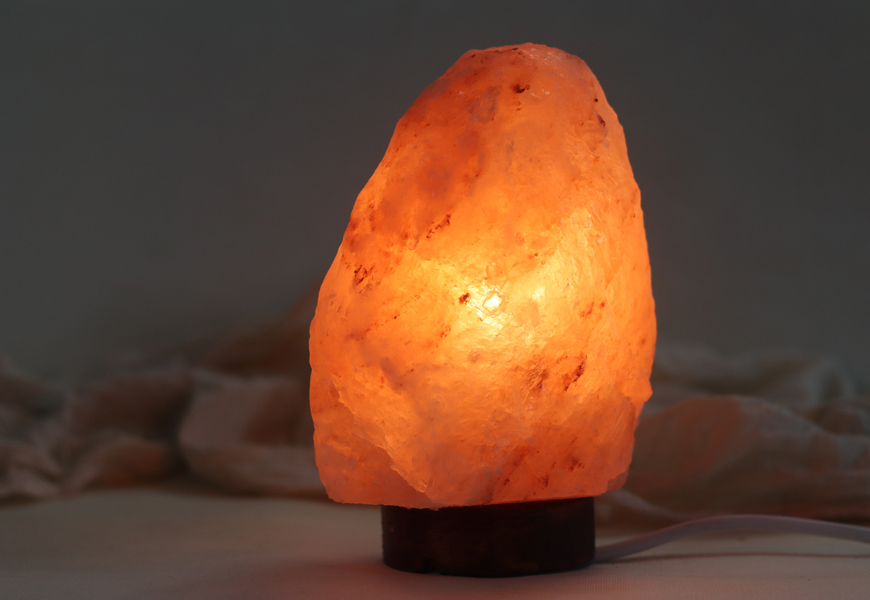Some people claim that Himalayan salt lamps can improve air quality, enhance your mood, and help you sleep…
In recent years, salt lamps have become a trendy addition to many households, beloved for their soft pink glow and unique aesthetic appeal and touted for their purported health benefits. These lamps, typically crafted from large salt crystals mined from Himalayan salt deposits, are believed by many to offer a range of advantages, from improving air quality to promoting relaxation. But amidst the growing popularity, it’s essential to examine the evidence behind these claims and figure out whether salt lamps truly live up to the hype.
A fixture of both spa decor and Instagram content, salt lamps are basically large, hollowed-out chunks of pink rock salt that contain a light bulb or other type of heating element. “Authentic” salt lamps are made from rock salt mined from the Himalayan mountains, usually in Pakistan, although it’s often hard to confirm this product’s true origins when purchasing it. When a salt lamp is turned off, it looks like a large, decorative, salmon-colored crystal sitting on a shelf. When it’s turned on, it produces a soft (some might even say “soothing”) pinkish glow.
Here’s what to know about what salt lamps can actually do—versus what marketing claims they can do.
The science behind salt lamps
Proponents of salt lamps argue that when the crystals are heated by the lamp’s bulb, they release negative ions into the surrounding air. Negative ions are believed to counteract the positive ions produced by electronic devices and other sources, potentially reducing indoor air pollution and improving overall air quality. Additionally, salt lamps are said to emit a soft, soothing glow that can create a calming ambiance and promote relaxation.
The potential benefits of salt lamps
Air Purification: While there is some evidence to suggest that negative ions may have air purifying properties, the extent to which salt lamps contribute to this effect is still up for debate. Studies have shown that high concentrations of negative ions can reduce airborne particulate matter, potentially benefiting individuals with respiratory conditions such as asthma or allergies. However, the concentration of negative ions emitted by salt lamps is relatively low compared to other sources, such as natural settings like beaches or waterfalls.
Mood Enhancement: The soft, warm light emitted by salt lamps can undoubtedly create a cozy atmosphere, which may help promote relaxation and reduce stress levels. Many people find the gentle glow of salt lamps to be visually appealing and conducive to a sense of well-being, especially in dimly lit spaces such as bedrooms or living rooms. While there is limited scientific research specifically examining the mood-enhancing effects of salt lamps, anecdotal evidence suggests that many individuals experience a subjective improvement in mood and overall comfort when using these lamps.
Aesthetics: Beyond their potential health benefits, salt lamps are prized for their unique and natural aesthetic appeal. Each lamp is one-of-a-kind, with variations in color, shape, and texture that add character to any space. The soft, rosy glow emitted by the salt crystals can create a warm and inviting atmosphere, making salt lamps a popular choice for interior decoration.
Considerations and caveats
While salt lamps can undoubtedly add a touch of charm to your home environment, it’s essential to approach their purported benefits with a critical eye. While some studies suggest that negative ions may have certain health benefits, the scientific evidence supporting the efficacy of salt lamps specifically is limited and inconclusive. Most of the health claims made about salt lamps stem from the idea that they supposedly release negative ions into the air. Scientists have been looking into the sources and potential benefits of air ions since the beginning of the 20th century and have found they can be generated naturally via waterfalls, rain showers, or thunderstorms. However, studies on the potential mental and physical health benefits of negative ions found in nature have largely come up empty, with no consistent or reliable scientific evidence of potential therapeutic effects. Furthermore, salt lamps require a heat source to function, which means they consume electricity and may pose a fire risk if not used properly.
At the end of the day you can’t deny that salt lamps have captured the imagination of many people with their intriguing blend of natural beauty and alleged health benefits. While they undoubtedly add a unique touch to interior spaces and can create a cozy ambiance, the scientific evidence supporting their purported health benefits is still lacking. Ultimately, whether you choose to incorporate salt lamps into your home decor should depend on personal preference rather than expectations of significant health improvements. As with any wellness product, it’s essential to approach salt lamps with a balanced perspective and consider them as one element of a holistic approach to well-being.












